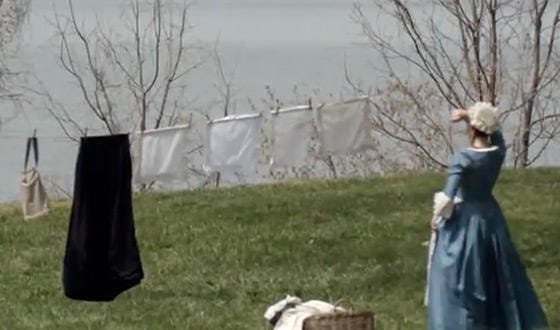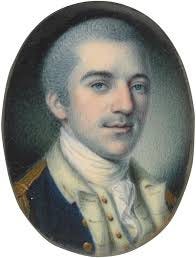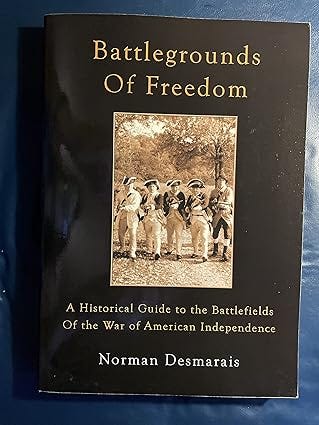#135: SC250: The History of Spy Networks in the Revolutionary War, Women In The Revolution, and Battlegrounds of Freedom
For South Carolina history lovers far and wide! Published weekly on Monday mornings. Enjoy weekly SC history articles, upcoming SC historical events, and other South Carolina recommendations.
Dear readers,
Welcome to SC History Newsletter #135!
I hope everyone is staying safe with the news of the wildfires in North and South Carolina.
Today, we are diving into some more SC250 Revolutionary War history — this time we’re learning about spies and espionage. A fun topic! I tried watching the AMC show Turn a few years ago, which is about Revolutionary War spies, but never finished. After writing today’s newsletter, I want to try watching again!
I’d like to welcome the following new subscribers as well! Thank you for joining the newsletter community :)
valeriedavis6119
Liddsec
carlfitz
Lucyslegacy
bondurant44
mamatiger96
Now let’s learn from SC History!
Yours truly,
Kate
(Writing from Greenville, SC)
➳ Housekeeping for new subscribers!
New friends! Please note that there are over 100 previous SC History newsletters on topics ranging from the founding of Charleston, sunken Confederate submarines, railroad tunnels filled with blue cheese, and more! See our archive here!
Send me your comments or topic ideas: I love it when subscribers write to me! Have a SC History topic or question you’d like for me to write about? Have additional ideas or feedback? Just reply to this email and let me know!
Join us on social: Keep the conversation going and join over 100 other subscribers by becoming a member of our SC History Newsletter Facebook Community here!
If your email “cuts off”: In your email app or website, if my emails “cut off” for you, please click the title of the email and it will take you to the full post on the Substack. I don’t want you to miss any content!
Love the SC History Newsletter? Please click the button below to share with a friend!
➳ Featured SC History Event of the Week:
Thursday, March 6th at 7:00 pm | “Women In The American Revolution” Lecture by Durant Ashmore | Laurens County Museum | Laurens, SC | TICKETS: Suggested $5 donation | Website
(Note from Kate: Thank you to subscriber Morgan W. once again for sending us this event to feature this week!)
From the event website:
“The Revolutionary War Lectures continue with Battlefield Preservationist and Historian, Durant Ashmore who will be emphasizing the heroines of the American Revolutionary War and their role in our Country's independence.
During the American Revolutionary War most women carried on with their daily tasks on the homefront, but many followed their men into war as cooks and caregivers. While others may have disguised themselves as men and joined the battles as spies and assassins.
The public is invited. Attendance is free to Museum members and youth. There is a suggested $5 donation for others for museum support.”
As a perk for paid subscribers, click here or the button below to visit my full SC History Events Calendar that organizes all the upcoming SC history events I have discovered. Please let me know if you’d like to add an event to the calendar! Reply to this email to send me your events.
➳ Other SC History Recommendations
(Note from Kate: Thank you to subscriber Tally J. for this book recommendation!)
BOOK: “Battlegrounds of Freedom: A Historical Guide to the Battlefields of the War of American Independence” by Norman Desmarais
(Note from Kate: Thank you to subscriber Doug K. for his recommendation of this book!)
Publisher’s Book Summary:
“Battlegrounds of Freedom is a fascinating travelogue through the battles of the American Revolutionary War, inviting readers to re-enact each battle vicariously exactly where and how it was fought.
Norman Desmarais carefully lays out the geographic and strategic contexts of each struggle, and he develops their human dimensions with anecdotes and stories.
-Conveniently organized by geographic location
-Maps and photos help retrace each battle in detail
-Websites noted for numerous historical organizations
-Abundant references to visitor centers, museums, and actual battleground sites.”
➳ SC History Topic of the Week:
The History of Revolutionary Spy Networks in SC
Spy networks were essential during the American Revolution. Both the British and American armies used spies to gather information about their respective enemies. In fact, the war may have involved espionage from the start.
From BattleFields.org:
“In a way, the American Revolution began with acts of espionage. Even a month before “the shot heard ‘round the world” Thomas Gage, the royal governor of Massachusetts, sent two subordinates to travel to Concord in March 1775 to gather information about patriots’ intentions and stockpiles of supplies and weapons. When British troops finally headed to Concord in April, their march was hardly the surprise that was intended—did someone close to the royal governor alert the patriots of their approach?”
British officers gathered intelligence from local colonial loyalist sympathizers, who advised them on local geography and terrain — unfamiliar to the British troops.
Some spies served for years at a time, while others were hired for singular missions. Both sides mounted “misinformation campaigns” that leaked false information to thwart the other side.
General George Washington relied heavily on spy networks. In fact, Washington is known as America’s first “Spy Master.”
In 1777, he wrote to Colonial Elias Dayton:
“The necessity of procuring good Intelligence is apparent & need not be further urged —All that remains for me to add is, that you keep the whole matter as secret as possible.”
Espionage was so important in the operations of the Revolution that in June 1776, Washington placed John Jay at the head of a newly formed Committee on Detecting and Defeating Conspiracies charged with the mission “to close the regular channels of intelligence from the city.”

One of the first agents to work on behalf of the patriot cause was Nathan Hale, who volunteered to spy on the British on Long Island in September 1776. Sadly, Hale was captured and hanged as a spy. He was patriotic to his last words, which were: “I only regret that I have but one life to lose for my country.”

Women and enslaved Africans — on both sides of the war — also served as spies.
From Battlefields.org:
“Women were fairly effective spies, for both sides, because they could pass through checkpoints and camps without raising too much suspicion or drawing too much attention to themselves. This was because women were a regular sight due to the presence of camp followers in and around the armies.”
Just one of many courageous examples of female spies in the Revolution was a woman named Anna Smith Strong. She was a patriot spy based in Setauket, Long Island and was a part of George Washington’s infamous “Culper Spy Ring” which was headed by Major Benhamin Tallmadge. Anna developed an ingenious way of sharing intelligence by arranging her laundry in specific patterns on her clothesline. If she hung a black petticoat on the line, a message was ready to be picked up. Arrangements of handkerchiefs on the line would signal where the message was hidden — in one of 6 local coves.

Spy rings throughout the Revolution used dead drops, codes hidden in plain sight (as in Anna Smith Strong’s clothesline above), messages written in invisible ink, letters hidden in ink quills and other objects, ciphers, and coded letters.

The Revolution also offered enslaved people the opportunity to gain their freedom through service as spies.
One of the most well-known black spies of the Revolution was James Armistead Lafayette. He was born enslaved in Virginia and was property of William Armistead. In the summer of 1781, French General Marquis de Lafayette recruited him to spy on the British. James pretended to be a runaway slave seeking freedom with the British army. He earned the trust of the British General Charles Cornwallis and was even privy to the general’s private papers, where he took notes of “troop sizes and the health and morale of the soldiers,” all of which James communicated back to General Lafayette. After the war, James Armistead petitioned for his freedom multiple times. Upon hearing that Armistead hadn’t yet been freed, the Marquis de Lafayette “wrote an affidavit attesting to his patriotic service.” The Virginia Assembly did eventually grant Armistead his freedom, and he thereafter took the surname Lafayette in honor of the Marquis.

South Carolina had its own network of spies including soldier John Laurens, an enslaved man named Antigua, and a teenager named Emily Geiger.
John Laurens was a South Carolina soldier and diplomat born in Charleston in 1754. He was the son of the prominent merchant and plantation owner Henry Laurens (See SC History Newsletter #16 on Henry Laurens). As a young man, he joined General George Washington’s staff and became “the best friend” of fellow aide Alexander Hamilton.
Laurens served in the forefront of battles of Brandywine, Germantown, and Monmouth and gained a reputation for “reckless bravery.”

He was elected to the South Carolina House of Representatives and in 1779 and 1780 proposed forming a regiment of slaves to serve in the war. He believed that slaves could “aspire to freedom in a republican society.” His proposals for this initiative were declined multiple times.
Fans of the musical Hamilton will remember Laurens’ lines in the show:
"But we’ll never be truly free
Until those in bondage have the same rights as you and me
You and I. Do or die. Wait till I sally in
On a stallion with the first Black battalion!"

In his final days serving the patriot cause, Laurens fought under General Nathanael Greene (see SC History Newsletter #122 on Nathanael Greene here) and operated a spy network that gathered intelligence on British activities in Charleston. Laurens was killed in a skirmish on the Combahee River on August 27th, 1782.
An enslaved man named Antigua also served as a patriot spy. He was property of John Harleston of St. John’s Parish in Berkeley County, SC. Harleston’s will made provisions for Antigua’s freedom as his “reward for his great attachment to my person and interests, and his ready and faithful discharge of duty to me in every capacity.”
During the war, Antigua worked for Governor John Rutledge “for the purposes of procuring information of the enemy’s movements and designs.” Antigua infiltrated British encampments and accessed valuable information on their activities — which he passed along to American forces.
During the British occupation of Charleston, Governor Rutledge summoned Antigua to carry letters to merchants who were under British protection but not Loyalists. The letters “contained a proposal beneficial to both the merchants and the Patriot cause.” Antigua was captured by the British while carrying these letters. What happened to Antigua after this incident is unknown.
On February 1783, Governor Rutledge petitioned to a committee of the South Carolina House of Representatives for the manumission of Antigua’s wife, Hagar, and their child as a reward for Antigua’s services as a spy. Hagar and her child were owned by Loyalist John Smyth whose property was confiscated at the close of the Revolution. On March 12, 1783, Hagar and the child were “forever delivered from the yoke of slavery” by the South Carolin General Assembly. Antigua was praised for his skill in “procuring information of the enemy’s movements and designs” and he “always executed the commissions with which he was entrusted with diligence and fidelity…. frequently at the risk of his life.”
At the young age of 16, Emily Geiger put her life on the line to deliver sensitive information for the patriot cause in 1781. Emily volunteered to be a courier for General Nathanael Greene, who needed an urgent message delivered to General Thomas Sumter (See SC History Newsletter #67 on Thomas Sumter here). General Greene believed that as a woman, Emily would attract less suspicion as his courier. Riding on horseback, Emily evaded capture on the first day of her journey, but on the 2nd day, the British forces stopped her. While waiting to be searched, Emily read and memorized General Greene’s message and then ate it! The British searched Emily, but finding nothing, released her. Thereafter, Emily rode to General Sumter, and verbally delivered General Greene’s message. As a result of Emily’s bravery, “Sumter’s forces met with other patriot forces at British-held Orangeburg to carry out Greene’s plan of attack.”

As a modern-day reader, it is hard to imagine the bravery and courage exhibited by the many spies — young and old, white and black, male and female, and others — who risked (and lost) their lives for the patriot cause.
We will end with a Revolutionary War-era song called Brave Paulding and the Spy (written in 1783) that paints another famous scene of espionage during the war.
John Paulding was a militiaman from the state of New York during the Revolution. In 1780, he was one of three men who captured Major John André, a British spy associated with the treason of Continental general and commandant of West Point, Benedict Arnold.
“COME all you brave Americans,
And unto me give ear,
And I’ll sing you a ditty
That will your spirits cheer,
Concerning a young gentleman
Whose age was twenty-two;
He fought for North America,
His heart was just and trueThey took him from his dwelling,
And they did him confine,
They cast him into prison,
And kept him there a time.
But he with resolution
Resolv’d not long to stay;
He set himself at liberty,
And soon he ran away.He with a scouting-party
Went down to Tarrytown,
Where he met a British officer,
A man of high renown;
Who says unto these gentlemen,
“You’re of the British cheer,
I trust that you can tell me
If there’s any danger near ?”Then up stept this young hero,
John Paulding was his name,
“Sir, tell us where you’re going,
And, also, whence you came ?”
I bear the British flag, sir;
I’ve a pass to go this way,
I’m on an expedition,
And have no time to stay.”Then round him came this company,
And bid him to dismount;
“Come, tell us where you’re going,
Give us a strict account;
For we are now resolvèd,
That you shall ne’er pass by.”
Upon examination
They found he was a spy.He beggèd for his liberty,
He plead for his discharge,
And oftentimes he told them,
If they’d set him at large,
“Here’s all the gold and silver
I have laid up in store,
But when I reach the city,
I’ll give you ten times more.”“I want not the gold and silver
You have laid up in store,
And when you get to New York,
You need not send us more;
But you may take your sword in hand
To gain your liberty
And if that you do conquer me
O, then you shall be free.”“The time it is improper
Our valor for to try,
For if we take our swords in hand,
Then one of us must die;
I am a man of honor,
With courage true and bold,
And I fear not the man of clay,
Although he’s cloth’d in gold.”He saw that his conspiracy
Would soon be brought to light;
He begg’d for pen and paper,
And askèd leave to write
A line to General Arnold,
To let him know his fate,
And beg for his assistance;
But now it was too late.When the news it came to Arnold,
It put him in a fret;
He walk’d the room in trouble
Till tears his cheek did wet;
The story soon went through the camp,
And also through the fort;
And he callèd for the Vulture
And sailèd for New York.Now Arnold to New York is gone,
A-fighting for his king,
And left poor Major Andre’
On the gallows for to swing;
When he was executed,
He looked both meek and mild;
He look’d upon the people,
And pleasantly he smil’d.It mov’d each eye with pity,
Caus’d every heart to bleed,
And every one wish’d him releas’d
And Arnold in his stead.
He was a man of honor,
In Britain he was born;
To die upon the gallows
Most highly he did scorn.A bumper to John Paulding!
Now let your voices sound,
Fill up your flowing glasses,
And drink his health around;
Also to those young gentlemen
Who bore him company;
Success to North America,
Ye sons of liberty!”
If you voted just “OK” on the newsletter today, I want to hear from you: what would you suggest I improve for next time? Please leave a comment below:
➳ Sources — The History of Revolutionary Spy Networks in SC
"10 Facts About Women During the Revolutionary War." American Battlefield Trust, www.battlefields.org/learn/articles/10-facts-women-during-revolutionary-war. Accessed 2 Mar. 2025.
"Black Spies in the American Revolution." American Battlefield Trust, www.battlefields.org/learn/articles/black-spies-american-revolution#:~:text=Perhaps%20the%20most%20well%2Dknown,Charles%20Cornwallis'%20camp%20at%20Yorktown. Accessed 2 Mar. 2025.
"Brave Paulding and the Spy Song." American Revolution, www.americanrevolution.org/brave-paulding-and-the-spy-song/. Accessed 2 Mar. 2025.
"Emily Geiger." South Carolina Encyclopedia, www.scencyclopedia.org/sce/entries/geiger-emily/. Accessed 2 Mar. 2025.
"George Washington, Spymaster." Mount Vernon, George Washington’s Mount Vernon, www.mountvernon.org/george-washington/the-revolutionary-war/spying-and-espionage/george-washington-spymaster/. Accessed 2 Mar. 2025.
"Isaac Hayne." George Washington’s Mount Vernon, www.mountvernon.org/library/digitalhistory/digital-encyclopedia/article/isaac-hayne. Accessed 2 Mar. 2025.
"John Laurens." South Carolina Encyclopedia, www.scencyclopedia.org/sce/entries/laurens-john/. Accessed 2 Mar. 2025.
"Spies of the Revolutionary War." American Battlefield Trust, www.battlefields.org/learn/articles/spies-revolutionary-war. Accessed 2 Mar. 2025.
"StoryMap: Revolutionary War Spy Freed in February 1783." South Carolina Historical Society, storymaps.arcgis.com/stories/22099cae5eac4bb1a5c2b6d8c9936547. Accessed 2 Mar. 2025.
"February 1783: Enslaved Revolutionary War Spy Freed Along with His Wife and Child." South Carolina Historical Society, schistory.org/february-1783-enslaved-revolutionary-war-spy-freed-along-with-his-wife-and-child/. Accessed 2 Mar. 2025.
"Revolutionary Spies." National Women's History Museum, www.womenshistory.org/articles/revolutionary-spies. Accessed 2 Mar. 2025.














